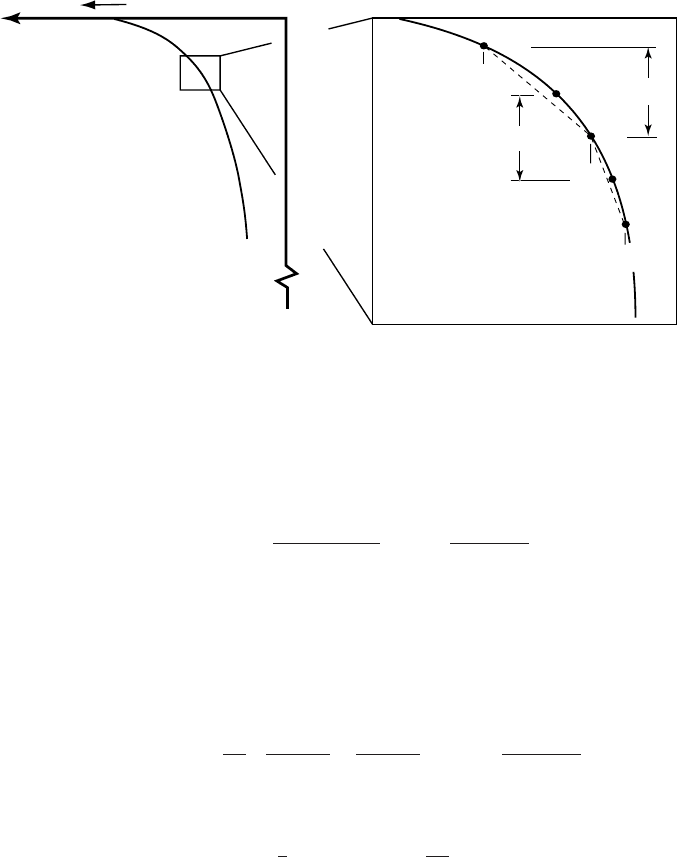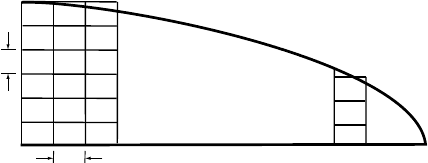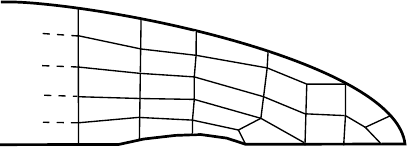Hooke R.L. Principles of glacier mechanics
Подождите немного. Документ загружается.


Finite-difference models 291
accurate results with fewer calculations, but the details are beyond the
scope of this chapter.
Finite-difference models
Finite-difference modeling is basically an extension of numerical inte-
gration. The defining characteristic of the finite-difference method is
that gradients in a parameter are approximated by obtaining values of
the parameter at grid points and dividing by the distance between the
grid points.
A simple example is the calculation of a temperature profile in the
ablation area of a glacier. The relevant equation is:
dθ
dz
= β
o
e
ζ
2
z
2
(11.3)
(Equation (6.29)) which, again, cannot be integrated analytically. We
start out, as before, by dividing the profile into n parts of equal height
z.Wethen calculate β
o
e
ζ
2
z
2
at the midpoint of the interval, z,or
alternatively at the end points and then average the two values. Either
approach yields an approximation of the average temperature gradient
through the interval z. Multiplying this by z gives an estimate of
how much the temperature decreases over this interval. Subtracting the
sum of these changes between this point and the bed from an assumed
temperature at the bed gives an estimate of the temperature at the top of
the interval z. Analytically, the equations for the second approach are:
θ
i+1
− θ
i
z
=
β
o
2
e
ζ
2
z
2
i+1
− e
ζ
2
z
2
i
so
θ
i+1
= θ
i
+ z
β
o
2
e
ζ
2
z
2
i+1
− e
ζ
2
z
2
i
(11.4)
Note that z = 0isatthe bed (Figure 6.4), so β
o
is the basal boundary
condition.
Equation 11.4 is easy to solve repetitively, but it still incorporates the
assumption that w varies linearly with depth (Equation (6.15)). Alterna-
tively, one could start with Equation (6.14):
0 = κ
d
2
θ
dz
2
− w
dθ
dz
(11.5)
thus avoiding this assumption. Note that Equation (11.5)isone-
dimensional inasmuch as θ and w vary only with z.Itcan be written
as
κ
dβ
dz
= w
dθ
dz

292 Numerical modeling
z
=
0
q
Colder
Height above reference level
z
i
z
i
−
/
1
2
z
i
+
2
/
1
q
i
z
i
−
1
q
i
−
1
z
i
+
1
q
i
+
1
∆z
∆z
Figure 11.2. (a) The upper part of a temperature profile in the ablation area of
a glacier. (b) Detail of area in (a) showing definitions of subscripts used in
Equation (11.6). Light dashed lines show approximations to temperature
gradients at z
i+1/2
and z
i−1/2
.
and then in finite-difference form as
κ
β
i+1/2
− β
i−1/2
z
= w
i
θ
i+1
− θ
i−1
2z
(11.6)
where β
i−1/2
and β
i+1/2
are, respectively, the average temperature
gradients at depths z
i−1/2
and z
i+1/2
, defined in Figure 11.2, and
z = z
i+1/2
– z
i−1/2
. Note that the gradient in β is taken over z
while that in θ is over 2z. Because β
i−1/2
= (θ
i
– θ
i
−1
)/z and
β
i+1/2
= (θ
i
+1
– θ
i
)/z, this becomes:
κ
1
z
θ
i+1
− θ
i
z
−
θ
i
− θ
i−1
z
= w
i
θ
i+1
− θ
i−1
2z
or
θ
i
=
1
2
(
θ
i+1
+ θ
i−1
)
− w
i
z
4κ
(
θ
i+1
− θ
i−1
)
. (11.7)
With Equation (11.7) one can use nonlinear variations in w with depth,
such as Equations (5.24)or(5.25). However, when θ
i
is being calculated,
θ
i+
1
is not known so one must set up a system of simultaneous equations
in order to solve the problem.
A rather similar problem is to calculate changes in a temperature
profile through time as the climate, and hence the surface temperature
changes. To simplify the problem, let us just consider seasonal changes
so we can restrict the domain to the upper 20 or 30 m of the glacier, and

Finite-difference models 293
thus neglect advection and strain heating. The appropriate differential
equation is then:
κ
∂
2
θ
∂z
2
=
∂θ
∂t
(11.8)
(Equation (6.30)). This is now a two-dimensional problem in which θ
varies with both depth and time. Proceeding as above, Equation (11.8)
can be rewritten in finite-difference form as:
κ
β
i+1/2
− β
i−1/2
z
t = θ (11.9a)
and then as
κ
1
z
θ
i+1
− θ
i
z
−
θ
i
− θ
i−1
z
t = θ (11.9b)
To continue, we need a profile to serve as an initial condition at time
t = t
0
.From this profile we can get θ
i
−1
, θ
i
, and θ
i
+1
and then solve
Equation (11.9a) for θ. This is the amount that the ice between z
i−1/2
and z
i+1/2
warmed or cooled during the time interval t. Once we have
done this calculation for every depth interval, z,wewill have the tem-
perature profile at time t
0
+ t, and a new calculation for the next time
step can be initiated.
To clarify the physics involved, consider the profile in the inset of
Figure 11.2 to be part of the temperature profile of interest. This pro-
file may have been measured, calculated during an earlier time step, or
assumed. The temperature gradient, θ/z,atz
i+1/2
is larger than that
at z
i−1/2
,somore heat will be conducted out through the top of the vol-
ume of height z than is conducted in through the bottom. Thus the ice
will become cooler during the time step. (With the coordinates shown in
Figure 11.2, both β
i−1/2
and β
i+1/2
are negative, so since β
i+1/2
is larger,
θ is negative (Equation (11.9a)).)
To model seasonal variations in the temperature profile, the boundary
condition at the surface must be changed appropriately at the beginning
of each time step. For example, if the initial profile was measured on
January 1 and we choose a time step of 0.02 a (or 7.3 days), the boundary
condition at the surface for the next iteration should be the temperature
(measured or estimated) 7.3 days later. If the temperature variation at the
surface is sinusoidal, the solution should closely approximate that given
by Equation (6.31) after a number of iterations. However, the present
solution has added versatility, inasmuch as accumulation or ablation can
be simulated by adding or subtracting increments of thickness, z,at
appropriate time steps.
Care must be taken in selecting t and z in such problems. The
finite-difference solution is said to converge (or be stable) if it approaches

294 Numerical modeling
the exact solution as t and z → 0. Our solution will converge
if:
0 <
κt
z
2
<
1
2
(11.10)
(Irons and Shrive, 1987,p.95; Carnahan et al., 1969,p.432). Thus, if
z = 1m,t would have to be less than about 1/75 of a year, or ∼5d.
If the integration had to span centuries or millennia and z could not be
increased, a very long calculation would be necessary.
Finite-difference techniques can also be used to integrate the momen-
tum equation, but simplified versions of the momentum equation can
be integrated analytically (e.g. Equations (5.6) and (10.42)), and ver-
sions including longitudinal stresses and varying ice thickness require
more advanced techniques, outlined below. Thus, we have focused on
the energy balance equation in these examples.
Because analytical solutions are not available for a large number of
differential equations of importance in science and engineering, consid-
erable effort has gone into refining the techniques we have just outlined,
and study of these techniques is now a major subfield of applied math-
ematics. As might be anticipated, the primary goals of this effort have
been to improve the stability and accuracy of the solutions without neces-
sitating ever finer grid spacing. A few common approaches are outlined
next.
Implicit methods
Equations like (11.9b)which use θ
i
−1
, θ
i
, and θ
i
+1
from a temperature
profile at time t
1
to calculate the profile at time t
2
are known as explicit
forms of the finite-difference equation. One could also write Equation
(11.9b) with θ
i
−1
, θ
i
, and θ
i
+1
defined as being the temperatures at time
t
2
which are, as yet, unknown. This is known as an implicit form. In this
approach, equations must be written for all n points in the profile, and the
equations then solved simultaneously for all the θ
i
. The temperatures
at time t
2
are then obtained by adding these θ
i
to the temperatures at
the respective grid points at time t
1
. This approach has the advantage of
being unconditionally stable so larger time steps can be used. Solution of
the equations is actually not as daunting as it may seem, as most contain
only three unknowns and those at the top and bottom, where the boundary
conditions are applied, contain only two. The resulting equation matrix
is a tridiagonal matrix with nonzero cells only on the diagonal and on the
sub- and superdiagonals immediately adjacent to the diagonal. Efficient
routines for solving such matrices are readily available.

Finite-difference models 295
Avariation on this implicit method is the Crank–Nicolson method.
In this approach, the gradients used in Equation (11.9a) are the averages
of the gradients at times t
1
and t
2
. Because gradients at time t
2
are
used, this is still an implicit method and requires solution of a system
of equations. However, the equations are only slightly more complicated
than those using just the gradients at time t
2
, and the increase in accuracy
is substantial (Carnahan et al., 1969,p.451).
Alternating direction schemes
One way to avoid stability problems in explicit methods is to use alter-
nating direction schemes. In such schemes, using the problem in Figure
11.2 as an example, one first calculates θ starting at the surface and
progressing downward, and then calculates θ for the next time step,
starting at the lower boundary and progressing upward. In the downward
direction, β
i−1/2
for time t
2
is calculated from the temperatures from
time t
1
, and β
i+1/2
is calculated from temperatures at time t
2
, thus:
κ
1
z
θ
i+1,t
2
− θ
i,t
2
z
−
θ
i,t
1
− θ
i−1,t
1
z
t = θ
i,t
2
− θ
i,t
1
(11.11a)
where the second subscript is the time step. This may be compared
with equation (11.9b). Here, θ
i+1,t
2
is known from the calculation at the
previous depth so a simple algebraic transformation leads directly to a
solution for θ
i,t
2
.Inthe upward direction, calculating temperatures for
time step t
3
, the appropriate equation is:
κ
1
z
θ
i+1,t
2
− θ
i,t
2
z
−
θ
i,t
3
− θ
i−1,t
3
z
t = θ
i,t
3
− θ
i,t
2
(11.11b)
Now, θ
i,t
2
and θ
i+1,t
2
are known from time step t
2
, and θ
i−1,t
3
is known
from the calculation at depth i − 1. This scheme, known as the Saul-yev
alternating direction procedure (Carnahan et al., 1969,p.451), is explicit
because calculations at any depth and time can be made using a single
equation. It is also unconditionally stable.
The Saul-yev procedure was used to model several temperature pro-
files in Barnes Ice Cap (Hooke et al., 1980). The study was motivated by
temperature measurements in boreholes that suggested a recent warming
at the surface and a systematic downglacier increase in the temperature
gradient at the bed. To model these profiles, Equation (6.13)was sim-
plified to two dimensions, thus:
∂θ
∂t
= κ
∂
2
θ
∂z
2
− u
∂θ
∂x
− w
∂θ
∂z
+
Q
ρC
(11.12)
and then expressed in finite difference form. The modeling suggested
that temperatures at the glacier surface had increased 0.1–0.5 K over

296 Numerical modeling
the past few decades, after a cooling in the early 1940s. The increase
in gradient at the bed appeared to be a consequence of a warming of
∼2Kabout 250 years ago, near the end of the Little Ice Age. Use of
an unconditionally stable finite-difference scheme greatly reduced the
computer time needed for the calculations.
Other explicit unconditionally stable procedures, some of which
also utilize alternating direction schemes, are available, as are implicit
alternating-direction methods (Carnahan et al., 1969, pp. 541–543).
Some of these are readily extended to two and three dimensions.
Backward, forward, and centered differences
In some of the examples above, we estimated gradients from tempera-
tures. If we know temperatures θ
i
−1
, θ
i
, and θ
i
+1
and need the gradient
β
i
there are three possible approaches:
dθ
dz
=
θ
i
− θ
i−1
z
dθ
dz
=
θ
i+1
− θ
i
z
dθ
dz
=
θ
i+1
− θ
i−1
2z
(11.13)
These are known as backward, forward, and centered differences, respec-
tively.
Non-dimensionalization
In writing computer code for finite-difference schemes, it should be
evident from Equations (11.4)to(11.11) that the code will be much
simpler if the units of spatial discretization (subdividing the domain
into many small discrete units) are of equal size. Thus, z should not
change with depth. If the problem at hand involves a substantial part
of an ice sheet, say along a flowline that is broken into columns of
width x, each of which is then subdivided into depth increments, z
(Figure 11.3), it is clearly impossible to keep both the number of depth
increments and their size, z, constant from one column to the next. To
avoid problems of this type, modelers commonly normalize the depth
by dividing by the thickness. Thus a point at a depth, z,of600min
an ice sheet that is H = 1000 m thick will be at a normalized depth,
z*, of 0.6. The columns then all have a non-dimensional thickness, H*,
of 1.0, and if they are each subdivided into 20 equal depth increments,
all increments will have a non-dimensional thickness of H*/20. Non-
dimensionalization or scaling of lengths in this way generally requires
scaling of the other parameters in the equations.

Finite-difference models 297
∆z
∆x
Figure 11.3. Illustration of
problems encountered with a
finite-difference discretization
of an ice sheet along a
flowline.
Such scaling greatly simplifies the mathematics in many situations.
However, results from such computations have to be restated in dimen-
sional form before most of us can derive useful physical insights from
them. As our goal is to develop an appreciation for physical concepts,
we will not delve further into this subject.
Shallow ice approximation
Most numerical models of ice sheets use what is known as the shallow ice
approximation. While the shallow ice approximation was first introduced
in glaciology by Fowler and Larson (1978) and in slightly different form
by Hutter (1981), our discussion is based on Hutter (1983,p.256ff). This
approximation makes use of the fact that the horizontal extent of an ice
sheet is large compared with its thickness. Longitudinal derivatives of
stress, velocity, and temperature are thus small compared with vertical
derivatives. If the wavelengths of major undulations in the surface and
bed topography are relatively long, so the surface and bed elevations are
slowly varying functions of x, the longitudinal coordinate can be scaled
by using the relation ξ = µx,where µ is small. One logical possibility is
to take µ as the ratio of the mean thickness to the horizontal extent of the
ice sheet. The vertical coordinate is not changed. With this scaling, µ is
introduced into the momentum balance, energy balance, and continuity
equations, and into the boundary conditions. If all terms involving µ
are then neglected and the resulting equations are solved, the solution is
referred to as the zeroth-order solution. In this solution, the stress and
velocity fields are calculated as if the ice sheet were a slab of uniform
thickness, and the basal shear stress turns out to be ρghα. Longitudinal
stress gradients are thus not included. If terms involving µ
1
are included
in the solution, the result is called a first-order solution. Longitudinal
stress gradients are included in this solution, and a flow law that includes
a linear term at low stresses is necessary to avoid a singularity in these
stresses at the surface. This is the solution used in most existing finite-
difference models of ice sheets. As might be expected from the above,
a solution including terms in µ
2
is called a second-order solution. In

298 Numerical modeling
Figure 11.4. A possible
finite-element discretization of
a tapered glacier margin,
showing the flexibility of the
finite-element method to
accommodate such
geometries.
modeling ice shelves, longitudinal stress effects first appear in second-
order solutions. Solutions including µ
2
or higher powers of µ are called
higher-order solutions.
Finite-element models
The finite-element method is another way of obtaining an approximate
solution to the governing equations. In both finite-element and finite-
difference models, the domain of interest is broken up into a large num-
ber of small elements. In early applications of finite-element models to
glaciological problems the elements were quadrilaterals, but commercial
packages now in use commonly have higher-order element geometries.
The corners of elements are called nodes. Unlike finite-difference mod-
els, in a finite-element model there is no advantage in making all of the
elements rectangular and the same size.
As before, parameters are assumed to be constant over the elements
or to vary in some simple way. In finite-element calculations, however,
use is made of the fact that the relevant differential equations can be
expressed in a form consisting of a sum of integrals. A solution method,
called the method of weighted residuals, then guarantees that the result-
ing approximate solution will be the best possible solution mathemati-
cally obtainable with a given element configuration.
While initially more complicated to understand, finite-element for-
mulations have been shown to be generally more stable, numerically, than
finite-difference formulations (Strang and Fix, 1973). Furthermore, ele-
ment shapes can be adjusted to conform to boundaries that would be
awkward to model with rectangular elements (Figure 11.4). Finally, ele-
ment size can be reduced in areas of high gradients and increased in areas
of low gradients, thus increasing accuracy without increasing computa-
tion time. Complex, non-uniform, and variable boundary conditions are
also easier to include in finite-element models.
Once a domain is discretized, stress or velocity conditions are spec-
ified at boundary nodes and equations are written relating stresses and
velocities at interior nodes to each other, to the mean stress in the ele-
ment, and to the stresses or velocities at the boundaries. As usual, the

Initial conditions and forcing 299
basic equations being solved are those for conservation of momentum,
mass, and energy (Equations (9.32b), (2.7), and (6.12a), respectively).
Glen’s flow law is normally used. For the simplest models utilized in
two-dimensional plain strain calculations, this procedure yields approx-
imately 2N + M equations where N is the number of nodes and M is the
number of elements. Twenty-five years ago a problem with 200 elements
and 300 nodes was considered large, but owing to advances in computer
technology and in numerical methods for solving large systems of equa-
tions, a typical problem today may involve thousands of elements and
nodes. The number of equations to be solved simultaneously is, thus,
large, but the number of unknowns in each equation is small, so effi-
cient routines for solving sparse matrices can be used. Owing to the
nonlinearity of the flow law, the set of equations is nonlinear and an
iterative solution is necessary. A trial solution is given initially, and this
is corrected to obtain an improved solution at each iteration.
The two most common types of finite-element model are two-
dimensional flow-band models and map-plane models. In flow-band
models, the model domain extends along a flowline, which may be curvi-
linear, and is bounded at the top by the glacier surface and at the base
by the bed or, in the case of some models that include temperature cal-
culations, by a surface at some depth in the substrate. The domain is
considered to be of unit thickness perpendicular to the flowline. Some
models permit one to specify a transverse strain rate, and thus become
quasi-three dimensional. A few are fully three dimensional (Hanson,
1995).
In map-plane models (Fastook and Chapman, 1989), the domain is
bounded by the surface and the bed and by lateral boundaries which
may be flowlines, a glacier margin, a divide, or an arbitrary transverse
boundary in the glacier across which a mass flux is specified. Unlike
flow-band models, map-plane models do not require prior knowledge
of the direction of flow. Although many map-plane models are called
three dimensional, they are actually quasi-three dimensional inasmuch
as the basic elements are columns extending through the ice mass, and
parameters such as velocity are averaged over the column. The models
are thus said to be vertically integrated.Insuch models, some terms of
the stress tensor are replaced by assumptions in the core of the model,
and variations with depth are then obtained later by, for example, using
equations like (5.16) and (5.18)tocalculate u(z) from
u.
Initial conditions and forcing
In earlier chapters we have found that it is necessary to specify conditions
on the boundaries of a problem domain in order to obtain a solution for
300 Numerical modeling
parameters within the domain. Vertical velocities at the surface were
specified in Chapter 5, temperatures and temperature gradients in
Chapter 6, and stresses and velocities in Chapter 10.Inall of these
examples, the solutions we sought were steady-state solutions, so all
time derivatives were 0.
In many modeling studies, time-dependent solutions are desired.
Indeed one of the strengths of numerical modeling is that we can study
the evolution of a complex system through time – a goal that is only
rarely achievable with analytical solutions (Equation (6.31)issuch an
exception). In time-dependent models it is necessary to specify condi-
tions at time t = 0, called initial conditions, and also, in most cases, the
temporal evolution of some of these conditions, usually those at the sur-
face. The latter is frequently referred to as the forcing.Wehave already
encountered an example of an initial condition earlier in this chapter, in
discussing the solution to Equation (11.8).
The choice of initial conditions depends on the extent of our knowl-
edge of those conditions. If there is no well-defined condition from which
to start the integration, it can be started with an unrealistic situation such
as a temperature profile that varies linearly with depth or an ice sheet with
a parabolic profile. This approach is particularly appropriate in problems
involving cyclical changes, such as seasonal changes in temperature at
the surface or changes in climate driven by variations in Earth’s orbit –
the Milankovitch cycles. The model would then be run through several
cycles until the solution at a given point in a cycle is essentially identical
to that at the same point in the previous cycle. One can then conclude
that the model has “forgotten” the unrealistic initial conditions. This
procedure is commonly referred to as a spin up of the model. The final
solution can then be saved for use as an initial condition in a subsequent
run.
Alternatively, one can start with a known condition at sometime in
the past. For example a model of cycles of ice sheet growth and decay
could use a condition of no ice sheet as an initial condition, or a two-
dimensional flowline model could use a profile measured 20 or 30 years
ago. In the latter case, the model could be validated by comparing the
final profile with one measured recently. The model might then be run
into the future to predict the effects of various climate-change scenarios.
As just noted, forcing a time-dependent model usually involves vary-
ing the boundary conditions at the surface in some prescribed way.
Boundary conditions at the bed or along an upstream or downstream
boundary might also be varied by the modeler, but more frequently these
will be calculated within the model as part of the solution. Relevant con-
ditions at the surface are usually precipitation and temperature. These
may be estimated from empirical relations, such as a relation between
